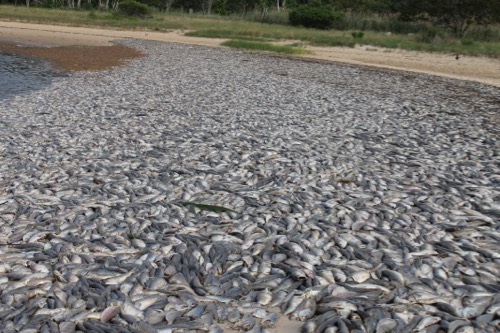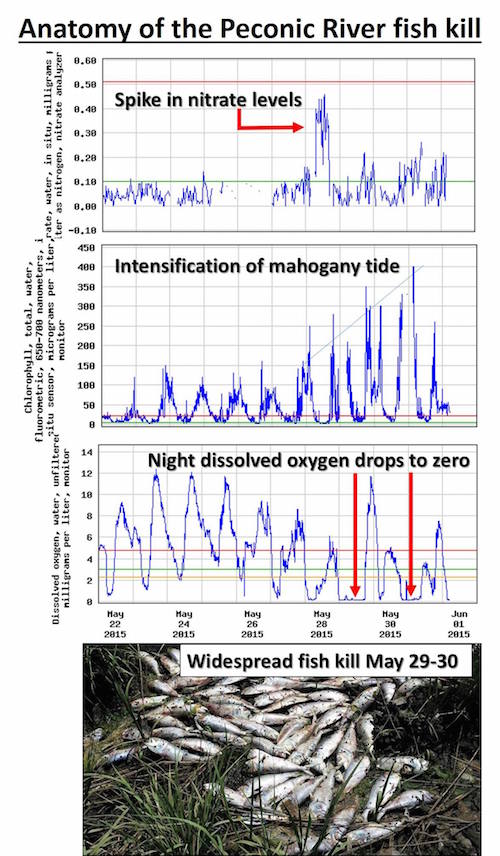As complaints begin to flow in about the tide of dead fish washing ashore on Flanders Bay beaches, local officials are making plans to remove at least the biggest piles of fish carcasses from local beaches, including the county park.
The Suffolk County Parks Department will collect and bury dead fish that have collected on the beaches at Indian Island County Park, Suffolk County Legislator Al Krupski said today after he visited the site. He met there this morning with Suffolk County Parks Commissioner Greg Dawson.
“Some of the dead fish seem to have been washed back into the bay by the tides,” Krupski said afterward. “The numbers on the beach are way less than yesterday,” he said. “We’re lucky with the east wind. It pushed enough water on shore to get the dead fish disburse. The seagulls have been working on them too.”
The county legislator said he still expected the county to have to do some cleanup because we want it taken care of “so when people come out next week they aren’t walking on them.” He said the county has not yet determined where the dead fish would be buried.
“Mother Nature is definitely helping,” Krupski said. “But it’s not likely to be enough.”

Photo: Denise Civiletti
Riverhead Town Supervisor Sean Walter said the town might have to take similar action and town engineering staff has been speaking with the state Department of Environmental Conservation about what it can do and where any fish that are collected may be disposed.
“Places like Simmons Point, we’re probably going to have to act. Other locations along the river, where the dead fish are in the reeds, unfortunately, we’re likely going to have to let nature take its course.”
The supervisor said his office has been fielding complaints from residents about the stench.
“We’ll work with residents to clean out the areas that we can clean,” Walter said.
Meanwhile, research scientists are pondering what might have caused the harmful algal bloom they believe to have caused the bunker die-off. Prorocetrum, dubbed “mahogany tide,” was present in Flanders Bay water samples at levels that were among the highest recorded in the region, according to Dr. Christopher Gobler of the Long Island Coastal Conservation Research Alliance and a research professor at Stony Brook University’s School of Marine and Atmospheric Sciences. Gobler has been studying the estuary since 2003.
Prorocetrum, like other algae, feed on nitrogen and large blooms are directly related to high nitrogen levels, scientists have found.
There was a significant spike in nitrate levels on Thursday May 28, according to U.S. Geological Survey data released by the Long Island Coastal Conservation Research Alliance today. That Thursday night, dissolved oxygen levels in the bay plummeted to zero for an extended period.
The dead fish began washing ashore on Friday.
When asked if the Riverhead sewage treatment plant had any reportable discharge events last week, Walter said he had not been informed of any. “We are under an obligation to report it and whenever something happens, I get an email, as does everyone else,” he said. “So I’d say definitely not.”
Walter said he believes last week’s rainfall, coming after an extremely dry period, caused runoff of fertilizers and other chemicals into the river and bay, which are responsible for the spike in nitrate levels. It rained in Riverhead on Thursday — there was a locally heavy downpour in the downtown area.
“That’s what I’ve been saying right along,” Walter said. “It was the rain that carried all that gunk into the water. That’ll do it.”
Stormwater runoff contains nutrients including nitrogen, which intensify the algae bloom, Gobler said today.
Today’s rain and rain in the forecast for tomorrow should initially dilute the the bloom, Gobler said. “However, it will bring more nutrients, so it could come back and intensify once again.”

The survival of local journalism depends on your support.
We are a small family-owned operation. You rely on us to stay informed, and we depend on you to make our work possible. Just a few dollars can help us continue to bring this important service to our community.
Support RiverheadLOCAL today.

































